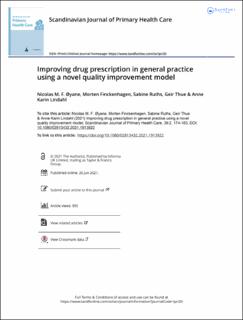| dc.contributor.author | Øyane, Nicolas Melchior Frederic | |
| dc.contributor.author | Finckenhagen, Morten | |
| dc.contributor.author | Ruths, Sabine | |
| dc.contributor.author | Thue, Geir | |
| dc.contributor.author | Lindahl, Anne Karin | |
| dc.date.accessioned | 2022-01-24T08:59:32Z | |
| dc.date.available | 2022-01-24T08:59:32Z | |
| dc.date.created | 2021-08-25T13:52:39Z | |
| dc.date.issued | 2021 | |
| dc.identifier.issn | 0281-3432 | |
| dc.identifier.uri | https://hdl.handle.net/11250/2838861 | |
| dc.description.abstract | Introduction
Quality improvement (QI) clusters have been established in many countries to improve healthcare using the Breakthrough Series’ collaboration model. We investigated the effect of a novel QI approach based on this model of performed medication reviews and drug prescription in a Norwegian municipality.
Methods
All 27 General Practitioners (GPs) in a mid-size Norwegian municipality were invited to join the intervention, consisting of three peer group meetings during a period of 7–8 months. Participants learned practical QI skills by planning and following up QI projects within drug prescription practice. Evaluation forms were used to assess participants’ self-rated improvement, reported medication review reimbursement codes (MRRCs) were used as a process measure, and defined daily doses (DDDs) of potentially inappropriate drugs (PIDs) dispensed to patients aged 65 years or older were used as outcome measures.
Results
Of the invited GPs, 25 completed the intervention. Of these, 76% self-reported improved QI skills and 67% reported improved drug prescription practices. Statistical process control revealed a non-random increase in the number of MRRCs lasting at least 7 months after intervention end. Compared with national average data, we found a significant reduction in dispensed DDDs in the intervention municipality for benzodiazepine derivates, benzodiazepine-related drugs, drugs for urinary frequency and incontinence and non-steroid anti-inflammatory and antirheumatic medications.
Conclusion
Intervention increased the frequency of medication reviews, resulting in fewer potentially inappropriate prescriptions. Moreover, there was self-reported improvement in QI skills in general, which may affect other practice areas as well. Intervention required relatively little absence from clinical practice compared with more traditional QI interventions and could, therefore, be easier to implement. | en_US |
| dc.language.iso | eng | en_US |
| dc.publisher | Taylor and Francis | en_US |
| dc.rights | Navngivelse 4.0 Internasjonal | * |
| dc.rights.uri | http://creativecommons.org/licenses/by/4.0/deed.no | * |
| dc.title | Improving drug prescription in general practice using a novel quality improvement model | en_US |
| dc.type | Journal article | en_US |
| dc.type | Peer reviewed | en_US |
| dc.description.version | publishedVersion | en_US |
| dc.rights.holder | Copyright 2021 The Author(s). | en_US |
| cristin.ispublished | true | |
| cristin.fulltext | original | |
| cristin.qualitycode | 1 | |
| dc.identifier.doi | 10.1080/02813432.2021.1913922 | |
| dc.identifier.cristin | 1928706 | |
| dc.source.journal | Scandinavian Journal of Primary Health Care | en_US |
| dc.source.pagenumber | 174-183 | en_US |
| dc.identifier.citation | Scandinavian Journal of Primary Health Care. 2021, 39 (2), 174-183. | en_US |
| dc.source.volume | 39 | en_US |
| dc.source.issue | 2 | en_US |

